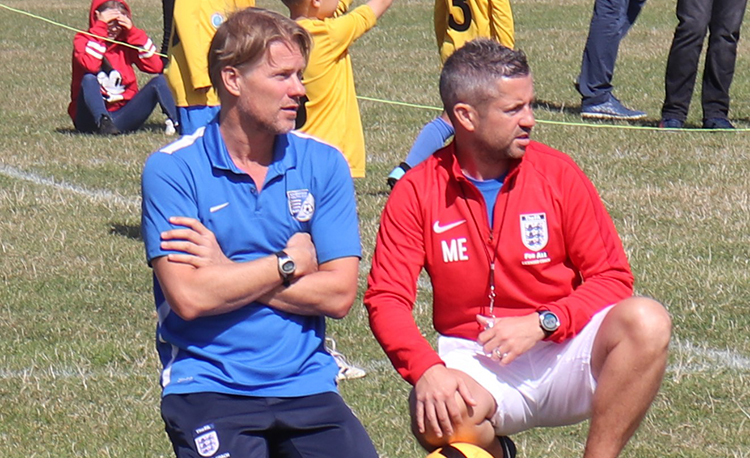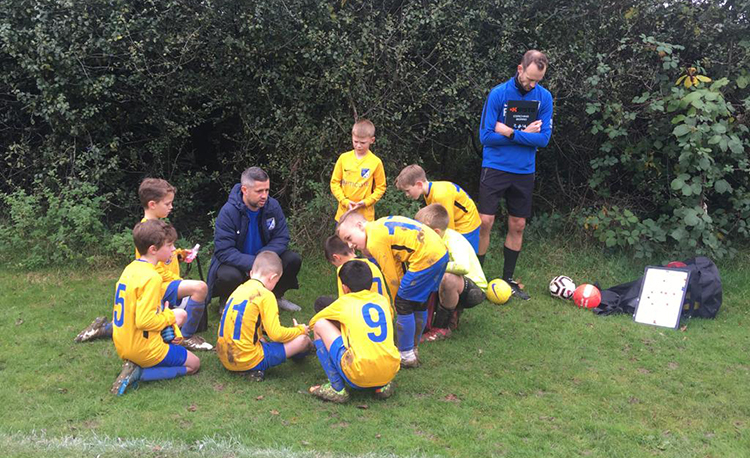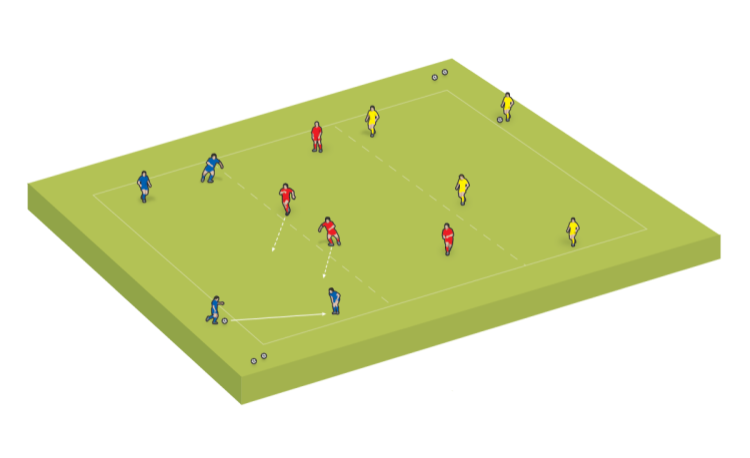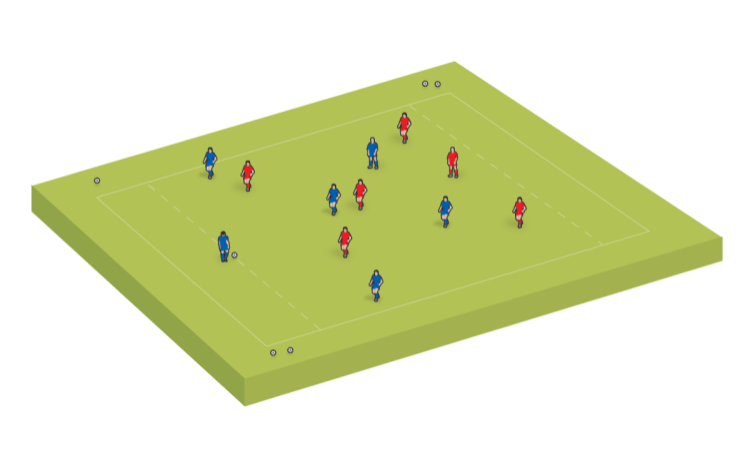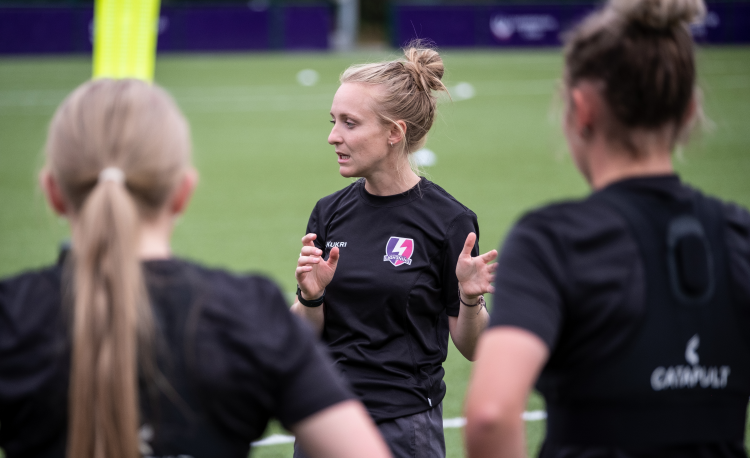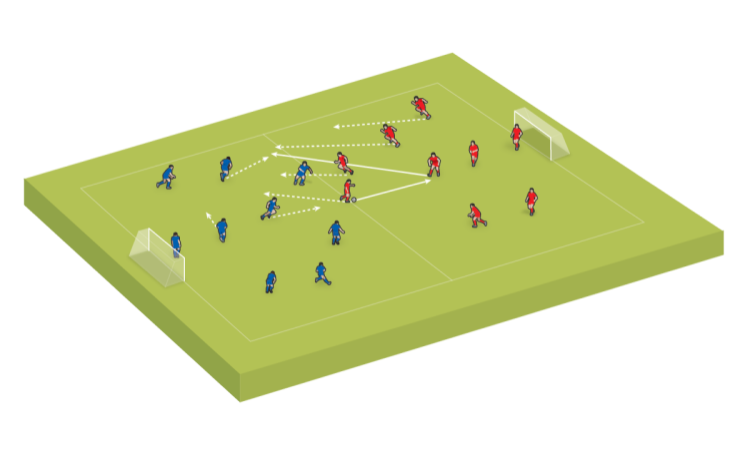Moving to seven-a-side: a rough guide
Under-10s coach MARK EDWARDS discusses the challenges and opportunities after switching up from five-a-side youth soccer, with SCOTT MOWBERRY
Like a large number of youth soccer coaches, Mark Edwards began life on the touchline when his son started playing.
Now, the Londoner has an FA Level 2 licence and is not only the Under-10s coach for Ickenham Youth Football Club, but also holds the title of youth development officer.
With his team, he has experienced the moves from five-a-side to seven-a-side, and recently from seven-a-side to nine-a side.
Each has presented its own challenges and opportunities, from ensuring equal playing time across a larger roster to introducing new and exciting concepts at training.
Mark spoke to his Ickenham coaching colleague Scott Mowberry - from our friends at the Soccer Coaching Podcast - about his coaching values, how he implemented them during the move to seven-a-side and what lessons he drew from the two formats…
SM: What is your current coaching philosophy and has it changed in the eight years you have been coaching?
ME: “I definitely think it’s changed a lot - not just the philosophy, but how I go about coaching and how a typical session would look.
"I actually documented my philosophy a couple of seasons ago. I think I had three points - one was around creating a positive environment, which is conducive for long-term player development and putting the player at the centre of the session.
"The second was about developing versatile players who were technically strong, comfortable with the ball in all areas of the pitch and able to make good decisions both in and out of possession.
"The last one, which I think was probably the most important for me, was designing fun training sessions where players are not afraid to try new things, and can make mistakes without any fear.
"If the sessions are not fun, then the boys or girls are not going to want to come back.
"My core values are a bit more streamlined. Number one was [to] be inclusive and treat all players equally, to the point where if someone came in, they wouldn’t know who my son was, if I’m coaching him.
"The second one is be prepared and organised, and finally work hard and always look to learn, which I think is really important when you’re a coach."
"Get it right at five-a-side, it makes the transition to seven-a-side straightforward..."
SM: What happens when a player has been told since they were six that they are a really good striker or goalkeeper and that’s all they have known for five or 10 years? Can you still promote versatility?
ME: "It’s so important to have that versatility and not pigeon-holing players at such a young age they don’t know how to play the other roles.
"As they get older, it gets harder to be able to do that - because, rightly or wrongly, it becomes more result focused.
"At that point, it’s hard for coaches to be able to play a player that can only play at the back in central midfield, or as a forward.
"The other thing to remember is that as you go through the older age groups, training gets a bit more tactically focused, and then a bit more position focused.
"So at U10s, U9s or U8s, you play a lot of small-sided games and don’t really have positions - or if you do, you rotate them.
"As they get older and it’s more tactical, then you probably have a bit more structure in terms of where players play, where their strongest position is, where they’re going to play on the Saturday or Sunday."
SM: What was five-a-side like and what were some of the things that worked to help you go into seven-a-side?
ME: "If you get it right at five-a-side, it makes the transition to seven-a-side a whole lot more straightforward.
"Firstly, it’s core values for the players - we had ‘respect, effort, fun’. That was clearly set out, and as we moved into seven-a-side, we just rolled that forward.
"So in terms of respect, they knew they had to respect each other, the coaches, the referee, the equipment, the opposition and the opposition coaches.
"Getting that drilled in at such a young age, means they carry that through into seven-a-side, nine-a-side and onwards.
"Obviously, the effort one is giving everything you’ve got. The last one is fun – you’ve got to enjoy yourself."
SM: In terms of squad numbers, how many did you have at five-a-side and how many did you have for seven-a-side?
ME: "We had seven at five-a-side and then when we moved to seven-a-side, one of the boys from the B team moved up to the A team, and we brought in a boy from another club to give us nine. So we had seven starters and two subs.
"We then went to 10 towards the second half of U10s, because I knew the transition to nine-a-side was coming. So we took another boy from our B team for the second half of the season.
"It become a bit more challenging with three subs, I must say. Two subs is ideal. Three subs is more challenging, especially when you’re trying to do the right things around equal game time and still doing player rotation."
SM: What were you doing over the summer, or pre-season, to get the players ready for seven-a-side? Were things changed much or was it just games and practice?
ME: "It didn’t change a lot. I prepared a document and sent it to the parents, saying this is the structure of how training is going to look and these are the coaches’ non-negotiables for this season.
"In terms of the structure, we maintained free play - so on arrival, we just let them play. That was player-led.
"We tried to do some agility games, or fun warm-up games, with the boys. We would do five or 10 minutes of that, then we would go into small-sided games.
"It would be 1v1s up to 4v4 or 5v5, because we didn’t have any bigger squad than that.
"We tried to use different-sized goals, different-sized pitches, sometimes no goalies, just a lot of versatility. Then we would do some ball-striking to finish the session.
"The difference between five-a-side and seven-a-side was, I think, two things. One is we probably did less 1v1 work and more 2v2 and 3v3 games.
"You’ve got a lot of 1v1 situations still but you’ve also got the option to share the ball with a teammate, so it just made the boys think a little bit more about sharing the ball.
"I sent a document to the parents saying ’this is how training is going to look’..."
"We did a lot of games where, if we had 10 boys, there would be two 2v2 pitches set up. You’d have eight playing and then two would be off.
"Then as soon as someone scored, the two that conceded would come off, two would go on and the two that scored would get the ball and shoot the other way.
"So it’s a lot around reaction, quick transitions, and sharing the ball. We [also] did a lot of work around the use of space and movement - things like can I play away from danger, dribble or pass, finding space and calling for the ball when our teammates have got it, and pressing and covering when we’re out of possession.
"We did a lot of things around switching the play, which has really benefited us as we’ve gone to nine-a-side actually. So [it would be] simple games where you might have wide channels and the boys have got to play into one channel before they score, then you progress it by playing into two channels.
"You might have two wide gates on the pitch and they’ve got to play through the gate before they can score, to encourage using the width of the pitch.
"We’ve done some things around possession and penetrative passing and we also did some work in terms of playing through the thirds. We split the pitch up into three zones, and they would have to pass through each zone.
"Again, I think that stuff has helped when they got to nine-a-side as well."
Related Files
Newsletter Sign Up
Coaches Testimonials

Gerald Kearney, Downtown Las Vegas Soccer Club

Paul Butler, Florida, USA

Rick Shields, Springboro, USA

Tony Green, Pierrefonds Titans, Quebec, Canada
Subscribe Today
Discover the simple way to become a more effective, more successful soccer coach
In a recent survey 89% of subscribers said Soccer Coach Weekly makes them more confident, 91% said Soccer Coach Weekly makes them a more effective coach and 93% said Soccer Coach Weekly makes them more inspired.
*includes 3 coaching manuals
Get Weekly Inspiration
All the latest techniques and approaches
Soccer Coach Weekly offers proven and easy to use soccer drills, coaching sessions, practice plans, small-sided games, warm-ups, training tips and advice.
We've been at the cutting edge of soccer coaching since we launched in 2007, creating resources for the grassroots youth coach, following best practice from around the world and insights from the professional game.
